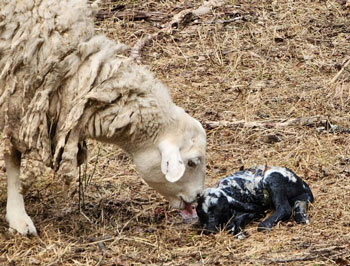Arkansas Extension Small Ruminants
Contact
Dr. Dan Quadros
Asst. Professor - Small Ruminants
Phone: 501-425-4657
Fax: 501-671-2185
Email: dquadros@uada.edu
University of Arkansas System
Division of Agriculture
Cooperative Extension Service
2301 S. University Ave.
Little Rock, AR 72204
Stay Connected!
| Follow us on Facebook |
Lambing/Kidding Season: What should I do to prevent losses?
By Dr. Dan Quadros1 and Nicole Nichols2
1 Small Ruminant Specialist, University of Arkansas System Division of Agriculture
2 County Extension Agent, University of Arkansas Cooperative Extension System
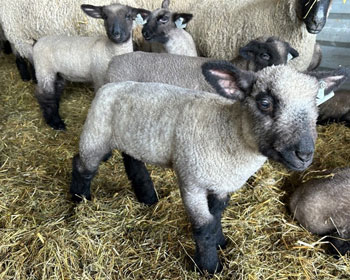 There is no doubt the most important time of the year in a small ruminant operation
is the lambing/kidding season. Not just because newborn lambs and kids are adorable,
but mainly because all your hard work is starting to pay off.
There is no doubt the most important time of the year in a small ruminant operation
is the lambing/kidding season. Not just because newborn lambs and kids are adorable,
but mainly because all your hard work is starting to pay off.
However, if things go wrong, your lamb/kid crop can be reduced, compromising profitability. For that reason, it generates an incredible level of stress on producers. Each loss that is avoided means more cash in your pocket.
Check out our tips to have a smooth lambing/kidding season and guarantee a high survivability rate for the offspring.
Why do we have a lambing/kidding season?
Common sheep and goat breeds raised in the US, when submitted to regular management, naturally concentrate the breeding (mating) season when the days become shorter during the fall. Consequently, they also concentrate the parturitions in the spring, when there are expected pleasant temperatures and flush forages for the future offspring.
Some producers will lamb and kid in late winter in order to sell animals when the market is at a peak. Having set breeding and birthing seasons can be advantageous when looking to get the best prices for animals.
What do I need to do before the lambing/kidding season gets started?
Before the lambing/kidding season begins, there are some considerations:
- Nutrition of the ewes/does: as most of the fetus growth occurs in the last third of
gestation, special care should be taken regarding dam diets because the capacity to
consume feed is significantly reduced. Diets need to be more concentrated on nutrients
to keep the body condition score (BCS) around 3-3.5.
(See body condition scoring of sheep and goats.) - In the case of wool sheep, crutch (removal of wool around the rear end and belly)
or shear the ewes.
- Vaccination with CDT (30 days prior to lambing/kidding) and other vaccines recommended
by your veterinarian, because antibodies can be transferred from the dam’s body to
the colostrum (first milk) and help to protect the offspring.
- Check for parasites using the Five Point Check.
- Prepare the lambing/kidding place, which can be a particular pasture or barn.
- Get lambing/kidding supplies including iodine (7%), towels, O.B. lube, O.B. gloves, lamb milk replacer, colostrum replacer, stomach tube, a halter or other restraint, needles, syringes, and any injectable vitamins you may need.

A lambing/kidding jug can prevent losses and benefit bonding.
When do I know the time is coming?
Parturition in sheep and goats occurs between 144-152 days and 145-155 days, respectively, after conception. About four weeks before parturition, animals start to develop the udder. Within 24 hours of parturition, the udder becomes firm, and teats become large, swollen, and filled with colostrum.
Other signs can be observed when they get close to giving birth, such as:
- She stays away from the others.
- Feed intake reduction.
- She paws at the ground or bed to make a “nest.”
- The vulva becomes swollen, and discharge may be visible.
- Vocalizations are common.
- Active contractions will begin, and the ewe/doe will arch her back and lie down and stand up repeatedly.
- Passing a water bag.
It is important to watch them closely to prevent significant problems. Baby monitors or wireless camera systems are beneficial when they give birth in barns.
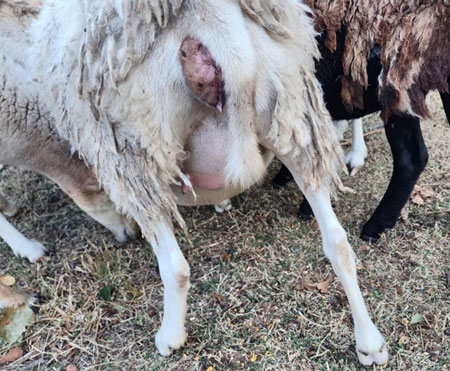
Ewe two weeks away from lambing.
When do I need to help?
Dystocia (or difficult birth) is one of the leading causes of newborn lamb/kid death. Common dystocia cases include abnormally long birth time (>30 min without any progress), head or shoulder lock, leg back (only one leg in the birth canal), or breech (backward) deliveries. Keep contact information for your veterinarian and more experienced producers on hand in case you need more guidance.
In case of assistance:
- Clean the area (vulva, anus) by washing with soap and mild disinfectant.
- Use long-sleeve disposable gloves and OB lube.
- Correct fetal position if necessary. You can hold the head but do not pull the animal by the jawbone. You can use a snare or lamb/kid puller to pull the young gently.
- Pull carefully in a downward direction as the mother strains.
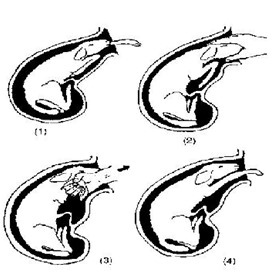
Source: Lambing and Kidding Parturtion
Important: Due to the possibility of zoonotic diseases (transmitted from animals to humans), pregnant women should avoid close contact with animals that are giving, or have recently given birth, afterbirth, or newborn lambs/kids.
What are primary care practices?
Ewes/Does
- Give fresh, clean water.
- Check both teats for milk production.
- If the mother has difficulty giving birth, check to see if a dead fetus is still in the uterus. If there is, remove, as this will cause an infection.
- If an ewe/doe has not passed the placenta after a few hours, bump the abdomen to determine if there is another lamb/kid to come. If so, carry out a careful internal examination, but do not pull the placenta. (See manual of lambing techniques for more information.)
Newborn lamb.
Lambs/Kids
- Newborn animals need to breathe immediately after bearing. Remove residual membranes from nostril (nose) with a baby nasal aspirator and stimulate breathing, if necessary.
- As newborn lambs/kids are wet and weak at birth, cold and windy weather can cause hypothermia (<100°F). Usually, the ewes/does will lick the baby after birth, but in case this is not done, you may help using towels to dry and massage them. A hairdryer also has been used successfully.
- Heat lamps in the lambing/kidding jugs must be used carefully to decrease fire hazards.
- Allow the newborn to suckle colostrum ASAP. Having frozen colostrum is very helpful (do not microwave it to thaw or heat). Additionally, milk replacers and a nutritional supplement may be necessary. Some lambs can be bottle-fed, but others require tubing.
- Let them bond with the moms.
- Cut the umbilical cord 2 inches from their bellies with disinfected scissors and disinfect navels with an antiseptic solution.
- If the dam is unable to rear the litter, you can try fostering.
- Identify the lambs/kids and register information.
- Castrating and tail docking can be recommended depending on the breed, fly strike occurrence, and market preferences.
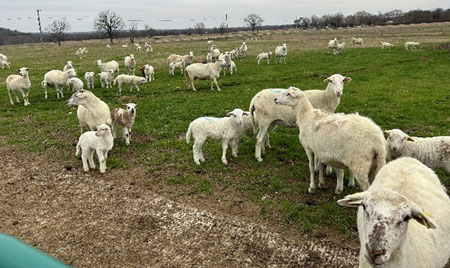
Adopting the best lambing/kidding practices will increase the survivability rate.
In summary
Lambs and kids have the highest mortality rate in the flock/herd. Being prepared is a crucial point. The care of the babies starts with the care of the moms. Appropriate nutrition and a healthy, comfortable, and safe environment are prerequisites for reducing the problems. Monitoring is a critical point in this process. Dams must do the job alone, but assisting them if necessary will increase your lamb/kid crop. Develop your own primary care protocol. I hope these tips help prevent losses and have a successful lambing/kidding season.
More information:
https://www.uaex.uada.edu/publications/pdf/FSA-9605.pdf
https://www.uaex.uada.edu/publications/pdf/FSA-9607.pdf
Additional resources:
Basic Lambing and Kidding Skills Webinar
Considerations for Pasture Lambing and Kidding
Goat Management Kidding Season
How to Reduce Losses at Kidding and Lambing Time
Lambing and Kidding Cheat Sheet for Beginning Producers
Lambing and Kidding Management
Veterinary Recommendations for Successful Lambing and kidding Season
